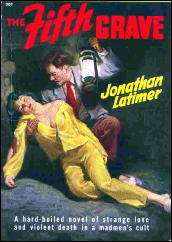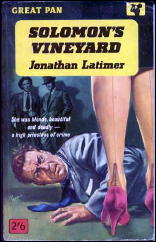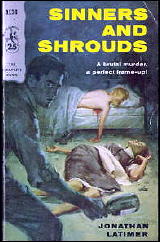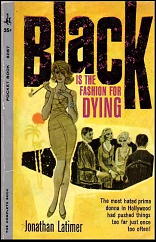Fri 14 May 2010
A 1001 MIDNIGHTS review: JONATHAN LATIMER – The Fifth Grave.
Posted by Steve under 1001 Midnights , ReviewsNo Comments
by Art Scott:

JONATHAN LATIMER – The Fifth Grave. Popular Library #301, paperback original; 1st US printing, 1950. Methuen, UK, hardcover, 1941, as Solomon’s Vineyard. Magazine appearance: Mystery Book Magazine, August 1946. Reprinted several times, including: Jonathan Press #J65, digest-sized paperback, 1950s; Pan, UK, pb, 1961. International Polygonics, pb, 1988; Neville, hardcover, 1982: limited edition, 300 copies, 26 additional bound in leather; first unexpurgated US edition. (Each of the latter two editions were entitled Solomon’s Vineyard. Note that the IPL paperback is also unabridged, and the Pan may be.)
This book has a curious history. Published first in England in 1941, it didn’t see book publication in the United States until 1950 as a paperback titled The Fifth Grave, and then only in drastically expurgated form.

The first line of the original is “From the way her buttocks looked under the black silk dress, I knew she’d be good in bed.” The paperback version is “From the way she looked under the black silk dress, I knew she’d be a hot dame.”
It wasn’t until a small California publisher reprinted it in 1982 that the original text saw American publication, and then only in a limited edition of 326 copies. This is most unfortunate, as Solomon’s Vineyard is a genuine hard-boiled classic and deserves wide availability. It has everything!
A private eye; a shoot-out at a roadhouse; necrophilia; a shoot-out in a steam bath; mobsters; a crooked police chief, a bizarre religious cult; a knife fight in a whorehouse; kidnapping; a mystery woman with a taste for kinky sex; human sacrifice; crypt-robbing — you name it, detective Karl Craven has to deal with it.

Craven, a crude but very tough investigator (very reminiscent of Hammett’s Continental Op in style and physique), arrives in the small Missouri town of Paulton to help his partner get a young woman out of the cult’s sanctuary, Solomon’s Vineyard, which dominates the life of the town.
He finds his partner’s been shot dead. Soon thereafter, he finds himself a target of the local mob, who control the countrywide vice operations in concert with the elders of the cult.
The cult’s founder, Solomon the Prophet, has been dead for five years, embalmed under glass for viewing on Sunday; but he takes a bride every year, and the brides mysteriously disappear just after the ceremony.

By “romancing” the cult’s priestess (the one with the black silk dress-and a fondness for S&M), he arranges a falling-out between the mob and the cult (a la the Op in Red Harvest), and ultimately finishes his job.
For this book, Latimer adopted an exceptionally terse first-person narrative style (the Bill Crane novels are told in more expansive third-person prose): The average sentence length is perhaps six or seven words. The comic elements are less overt, but he indulges his taste for Grand Guignol with evident relish.
Solomon’s Vineyard is clearly Latimer’s homage to the classic hard-boiled detective story, made obvious by Craven’s reading Black Mask during a couple of brief lulls in the action (shades of Bill Pronzini’s “Nameless”). As such it is a brilliant success, and deserves to be ranked with the best of Hammett, Whitfield, Cain, Davis, Chandler, et al.

Other fine Latimer novels, all but the last two with Bill Crane: Murder in the Madhouse (1935), Headed for a Hearse (1935), The Dead Don’t Care (1938), Sinners and Shrouds (1955), and Black Is the Fashion for Dying (1959).
———
Reprinted with permission from 1001 Midnights, edited by Bill Pronzini & Marcia Muller and published by The Battered Silicon Dispatch Box, 2007. Copyright © 1986, 2007 by the Pronzini-Muller Family Trust.